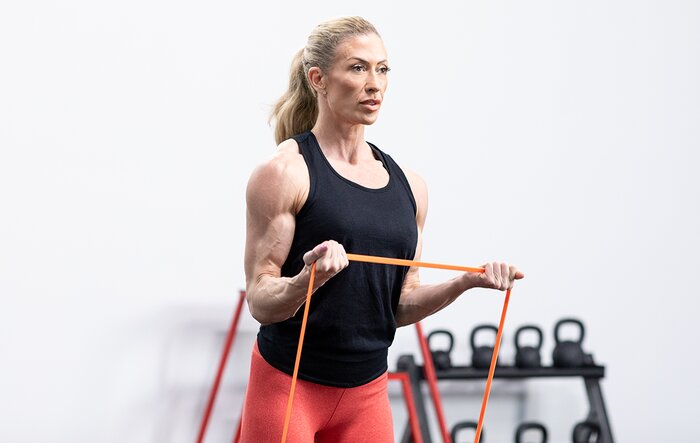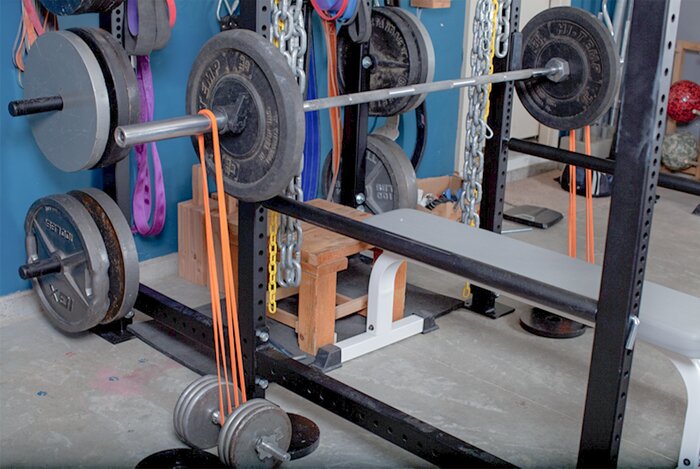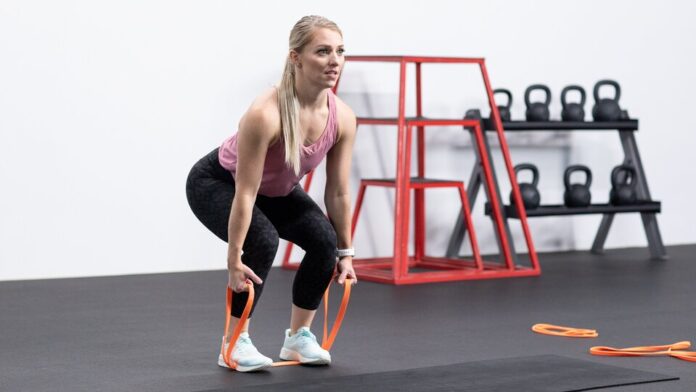[ad_1]
When circumstances are beyond our control, we sometimes have to get creative with our training. Perhaps it’s finding ways to get in sessions at home when the gym just isn’t an option, or maybe we seek training alternatives to come back after an injury or time off.
If you face any of these situations, or if you just want a different way to get the job done, resistance bands are the tool you need to add to your tool bag, or rather, gym bag. Bands provide numerous benefits that will make even the most hardcore iron disciples decide they are worth the investment.
Here are 10 reasons why you should believe in bands:
Table of Contents
1. They Offer Different Levels of Resistance
Much like weights, bands offer different levels of resistance, everything from lightweight rehab therapy to heavy-duty pull-up assists. Even a single band can double in resistance if you simply double it up.
With bands, you’re not limited to one size for all exercises. You can buy different sizes for different levels of resistance. Use lighter bands for smaller muscle groups like biceps or triceps and larger bands to train your legs or back.
2. Bands Are Budget Friendly
Another great benefit of resistance bands is that they aren’t a huge financial investment. As long as you have a few resistance levels to choose from, you can perform a lot of exercises without spending a lot of money. Since they provide resistance in virtually any direction, investing in a couple of bands sure beats trying to buy a universal machine or a bunch of free weights for your garage.

Bands can also be used with the equipment you already have, meaning you don’t have to throw out all your old equipment to make room for some space-hogging apparatus. Bands play well with any training style, as well, making them as at home in a strongman gym as they are in a yoga studio.
3. They Can Help Improve Flexibility
Many of us could stand to improve our flexibility, especially those of us who lift. Bands can be very effective in helping you stretch those tight muscle groups to increase reach and range of motion. Beyond just the training benefits, better mobility and flexibility can have a positive impact on your overall health and wellness.
4. Bands Make for an Effective Warm-Up
One of the best ways to warm up is by mimicking movements you would be doing in your workout with lighter weight. Bands are especially helpful for warming up and pumping blood into muscles, which is the reason they have been a behind-the-scenes staple of bodybuilding competitions for decades.
To warm up with bands, simply replace your machine or free-weight movement with a band exercise that mimics it. For example, if you’re doing shoulder presses, take one end of the band in one hand, stand on the other end, and perform reps on each side to warm up the shoulder and prepare the muscles for the extra volume and intensity that lies ahead.
5. Bands Help Create Greater Muscle Contraction with Little Joint Impact
When you perform a contraction with a band, it creates a tension that forces the muscle to contract even more as the band stretches. That means you have to work harder to maintain the contraction. Done properly, adding bands to your curls or chest presses will bring you a new level of hardness and density.
Furthermore, the added resistance of bands won’t take a toll on your joints like moving up to heavier plates or dumbbells would. The natural relaxing of the band as you return to the starting position means immediate relief for your joints that free weights can’t provide. You can increase the work for your muscles while reducing strain to your knees, shoulders, or lower back, depending on the exercise.

6. They Can Provide Bodyweight Assistance
An exercise that many people struggle with is the pull-up. One of the most popular ways to improve on this bodyweight staple is to use extra assistance, usually in the form of a machine or an able and willing training buddy holding your feet.
Not every gym has an assist machine, and spotting yourself is not ideal. If mastering the pull-up is your goal, just loop the band around the pull-up bar and place your foot or knee in the bottom loop of the band to perform the exercise. The band provides that extra spot right when you need it to help you to reach your reps.
7. They Can Provide Extra Resistance
Of course, bands work the other way, as well. Wrap one end of the band around your body and the other around the bottom of the pull-up station you’re using. The band stretches when you pull yourself up, forcing you to work harder than you would with your body weight alone. Push-ups, squats, dips…bands allow you to add resistance easily to all your favorite bodyweight exercises.
It doesn’t stop there: Bands can just as easily add dynamic resistance to free weights and machines, especially when the stack isn’t enough. Just place the ends of your band around the handles of the machine with the middle of the band around the center. This is a quick and easy way to add extra tension when you lift. Anchor a band behind the bench and hold each end with your dumbbells as you perform flat or incline presses. You’ll work harder at lockout and during the negatives. You’re welcome.
8. Bands Offer New Ways to Do Tricky Exercises
Bands offer an alternative method for doing exercises you may not feel comfortable doing otherwise. One example is good mornings. A traditional good morning is performed by hinging at the hips with a barbell across the back of your shoulders to strengthen the posterior chain.
Some lifters have trouble with this movement due to not being flexible enough to hold the bar in the correct spot across their shoulders as well as having lower back pain from supporting the weight while bending over. Performing the exercise with a band helps minimizing these issues. Using a band puts less strain on the shoulders to hold the band in place, and the resistance is weakest at the bottom of the movement when the lower back is most compromised.
You can also use bands for isolation exercises that are difficult to perform evenly with free weights, such as curls. A dumbbell is just as heavy at the bottom of the curl as it is at the top, which means your weaker arm usually reaches failure first. Bands, on the other hand, are easier to lift at the bottom of the curl and increase in resistance at the top, matching the strength curve of your biceps and allowing you to work both arms more efficiently without having to adjust your weights.

9. Bands Are Great for Finishers
As mentioned previously, bands can push a lot of blood into your muscles. In addition, their dynamic resistance provides an endurance challenge, making them a great tool for finishers. Not only will bands help you perform extra reps at the end of your workout, but you’ll also fight the natural negative of band tension.
An optimum choice for a band finisher is something like a rear delt pull-apart. Hold each end of the band in front of you at arms’ length. Pull your hands apart as far as you can while keeping your arms straight, targeting the rear delt. Hold that position for a second and return to the starting position, resisting the pull of the band to maintain tension throughout the movement. Repeat until failure.
10. They are Highly Portable
One of the best understood benefits of bands is that they are portable. Once you’ve mastered using bands in your routine, you have everything you need to get a great workout at all times.
Throw a set of bands into your luggage before you hit the road, or just keep a set in your gym bag so you always have them with you when you work out. Bands don’t take up much space and hardly weigh anything, and most band exercises can be done in a hotel room, a garage, or a corner of your gym. If your normal gym is closed or you just can’t make it in, you always have options if you have bands.
[ad_2]
Source link












